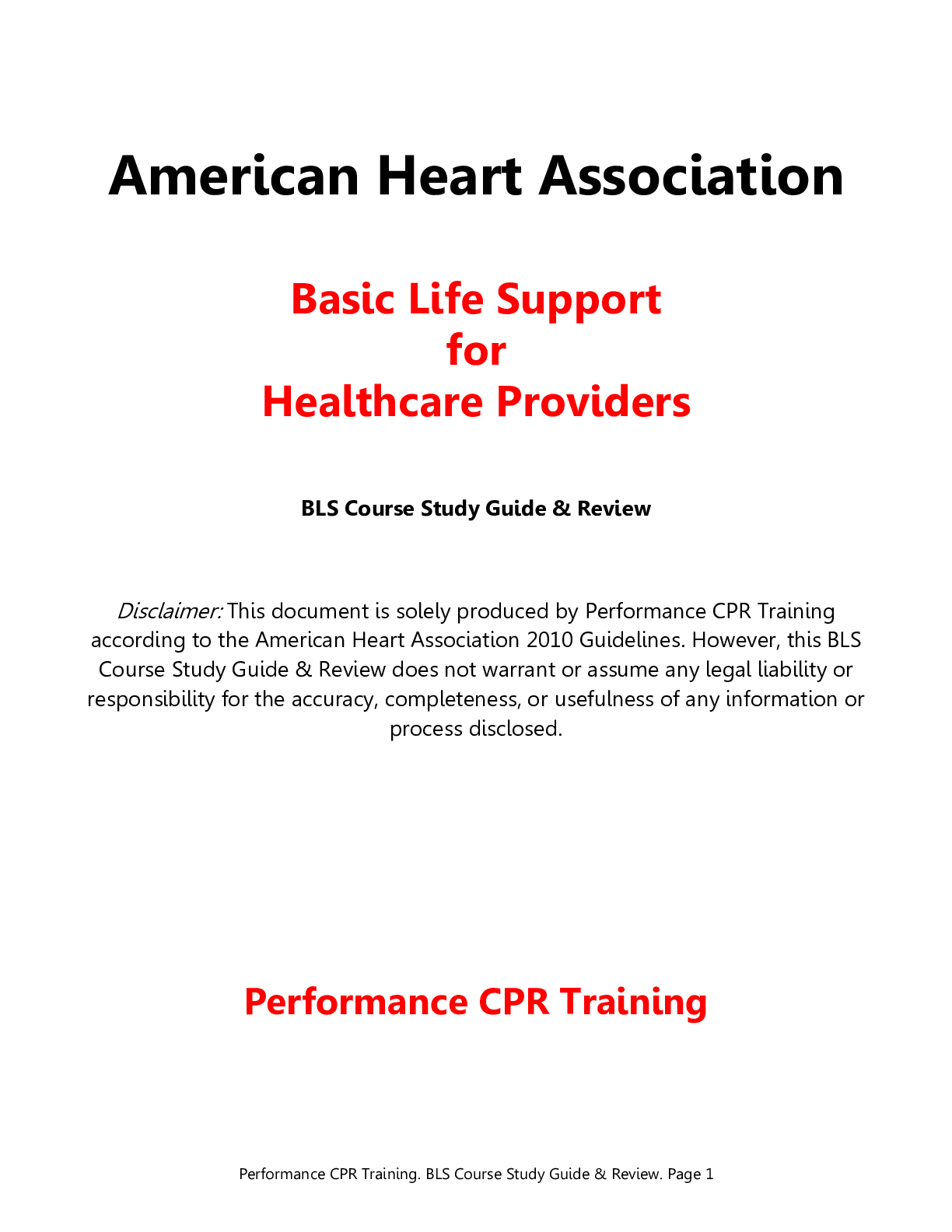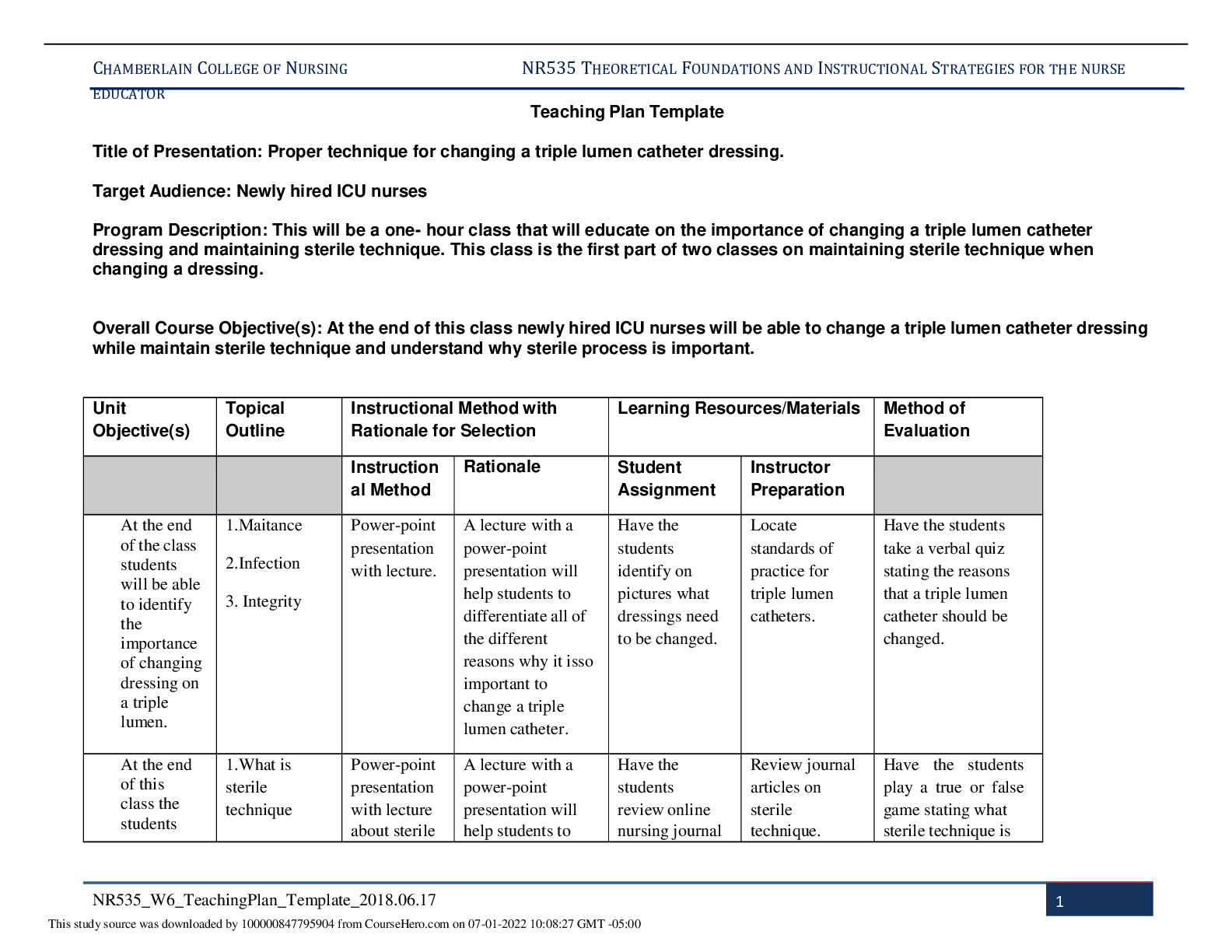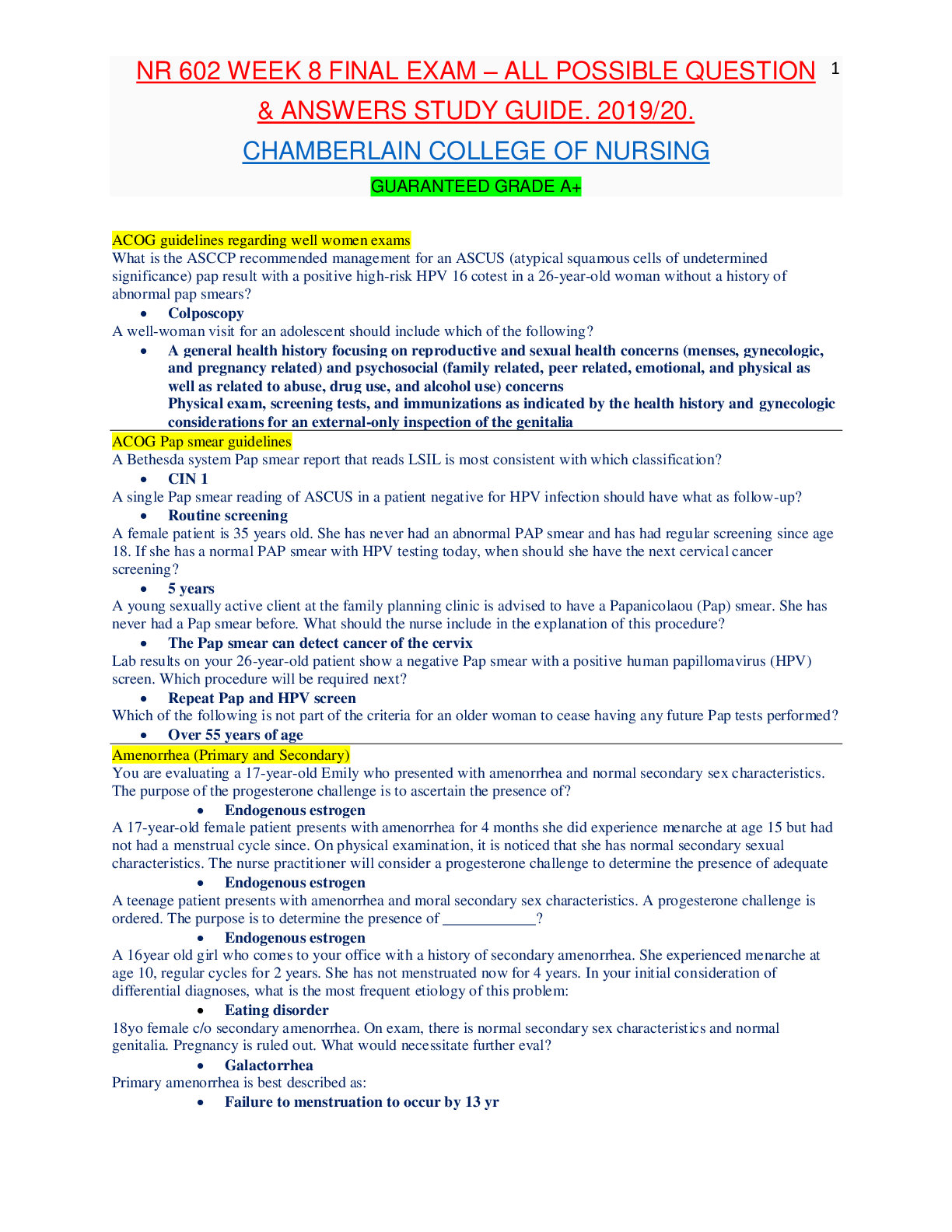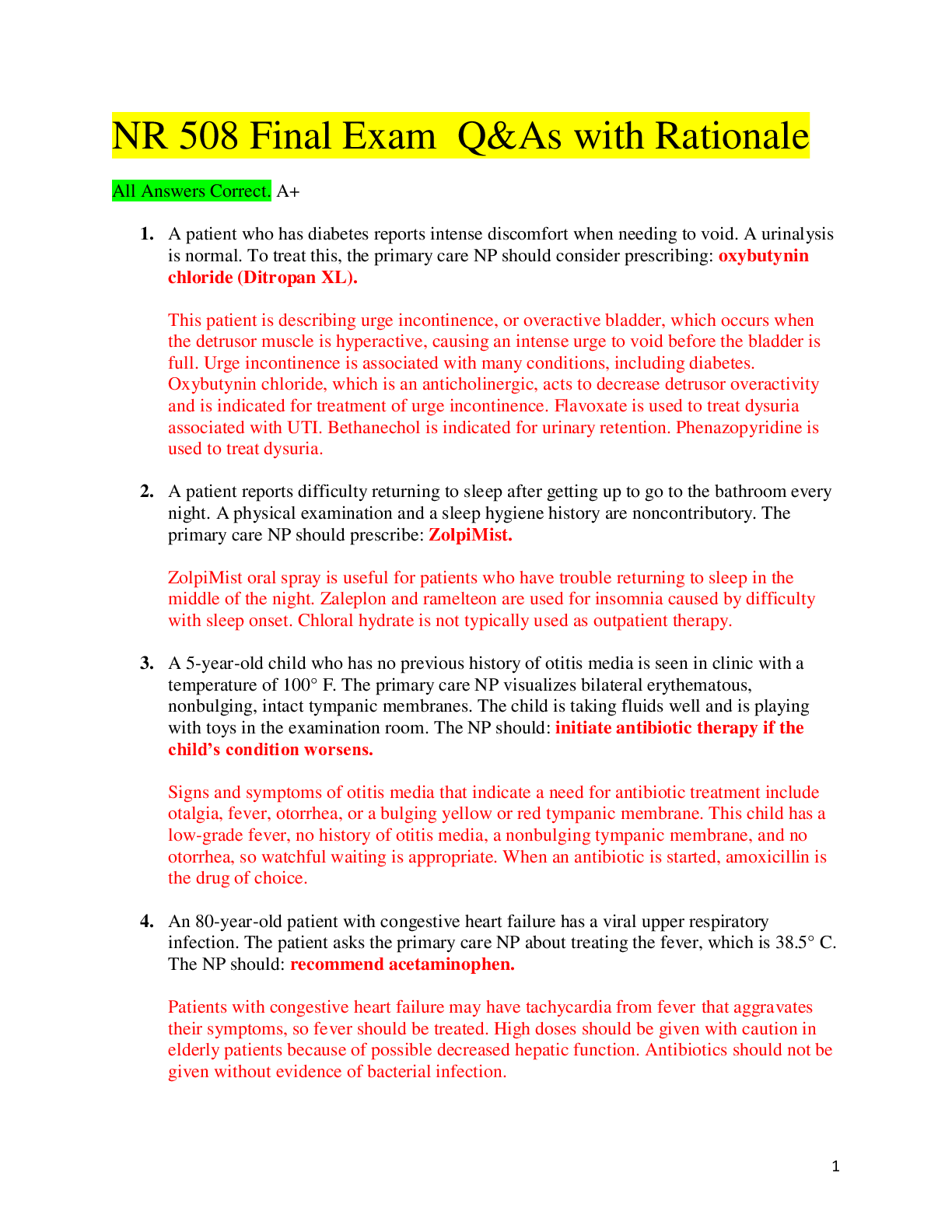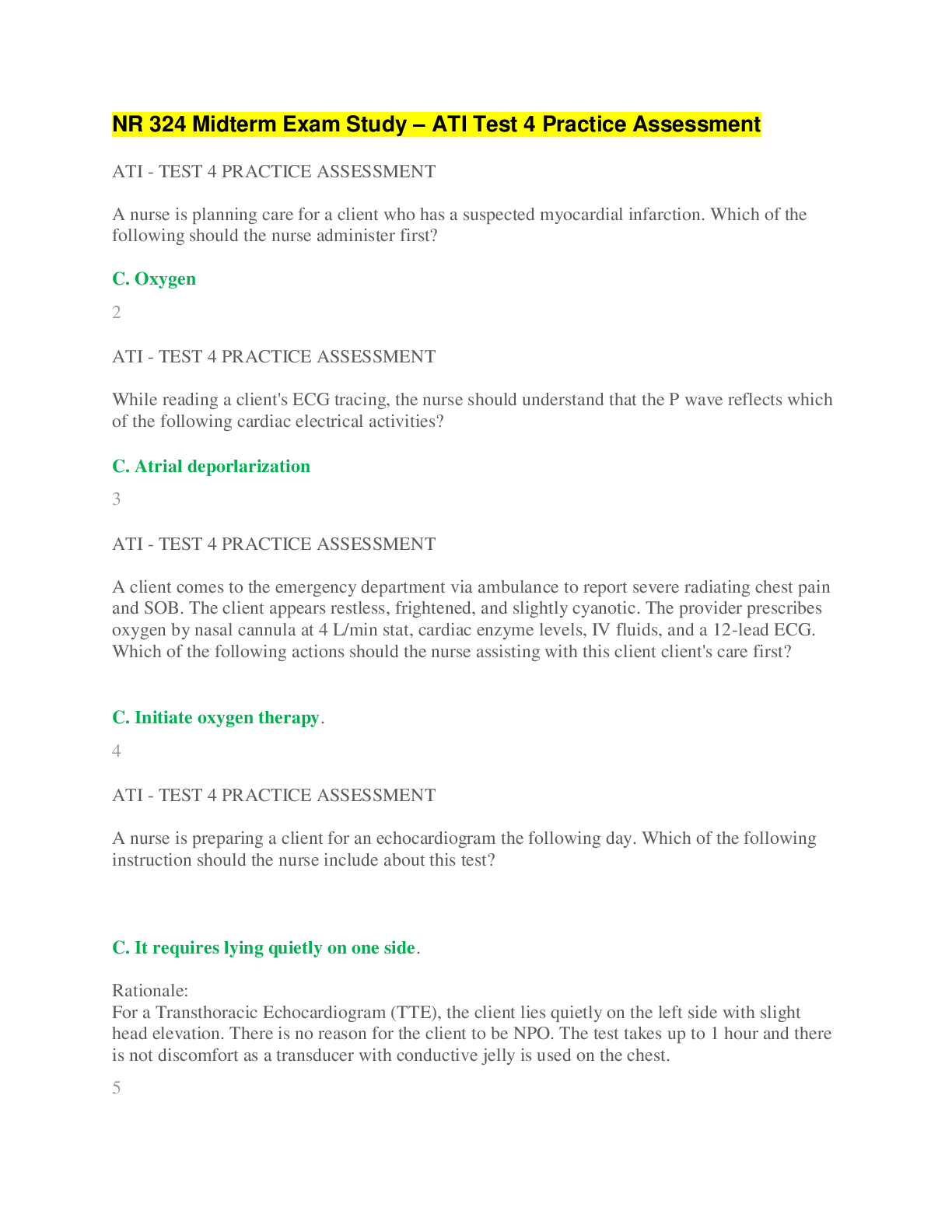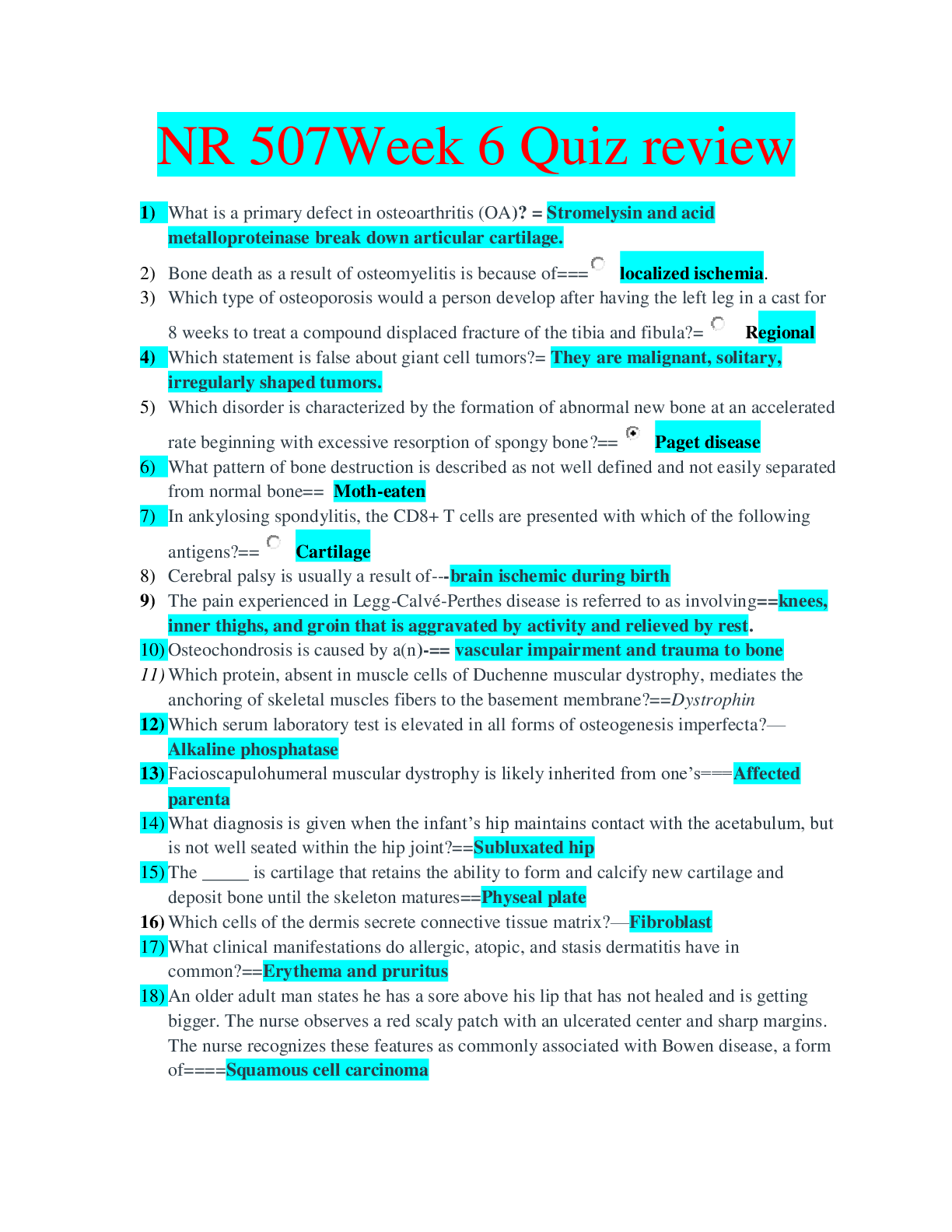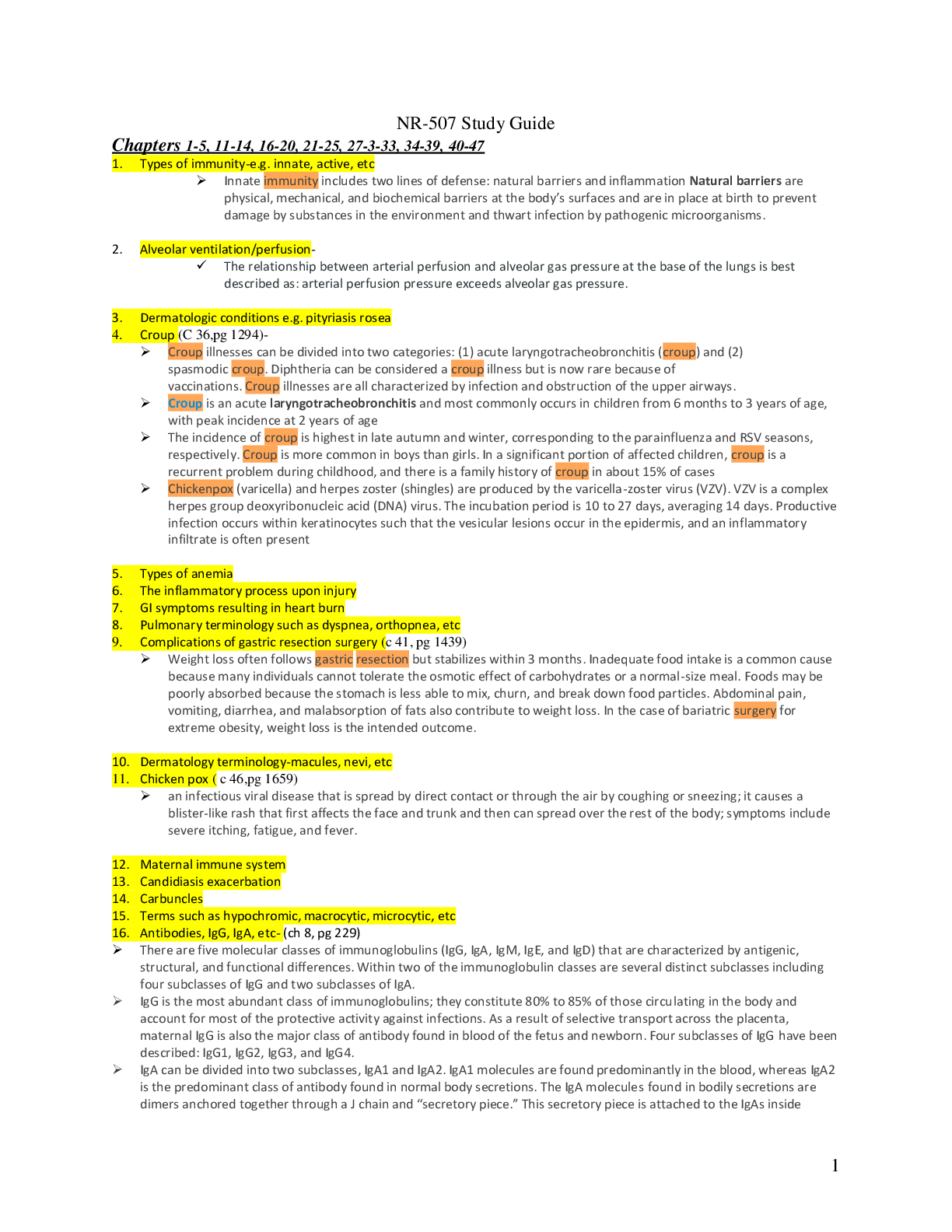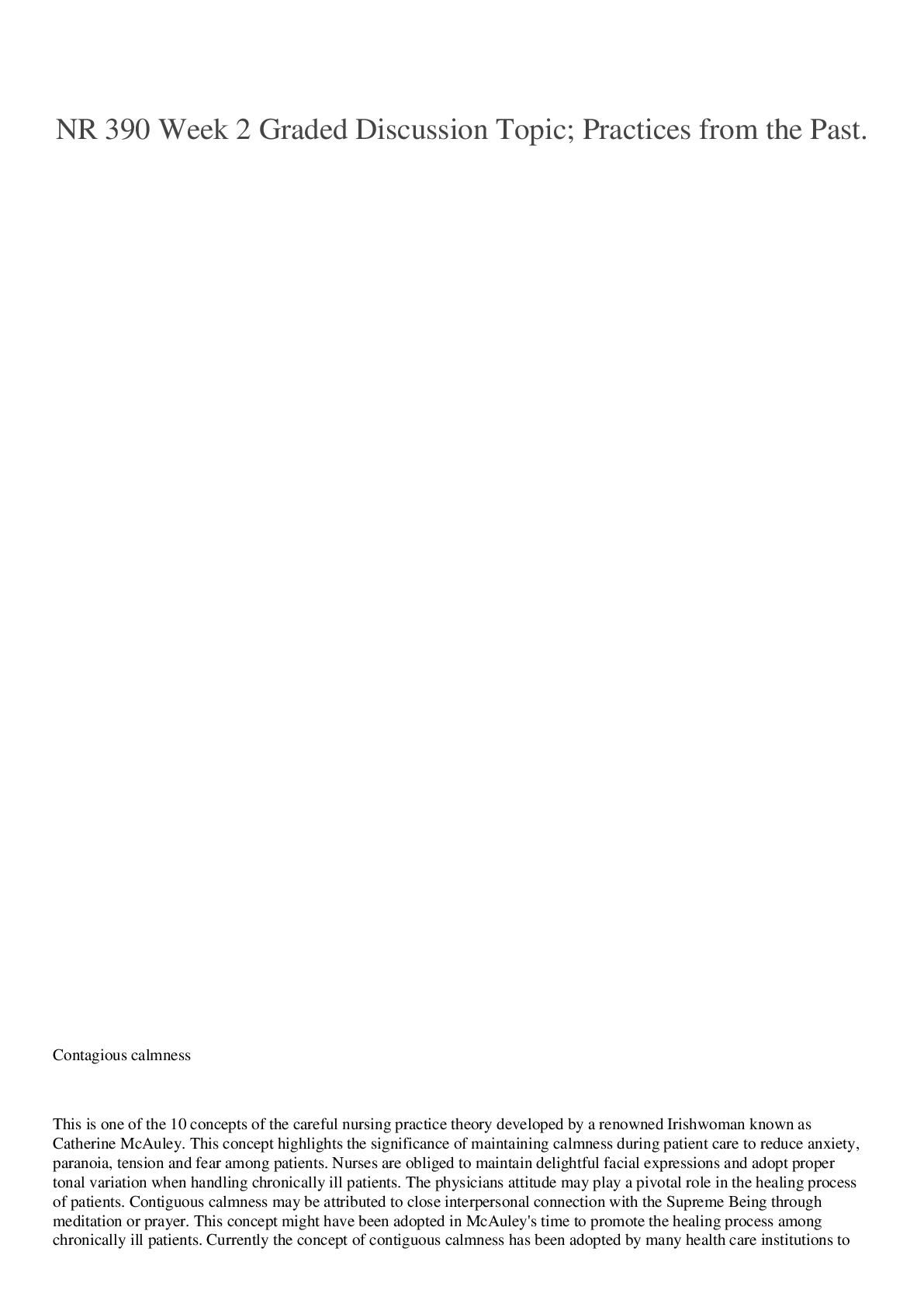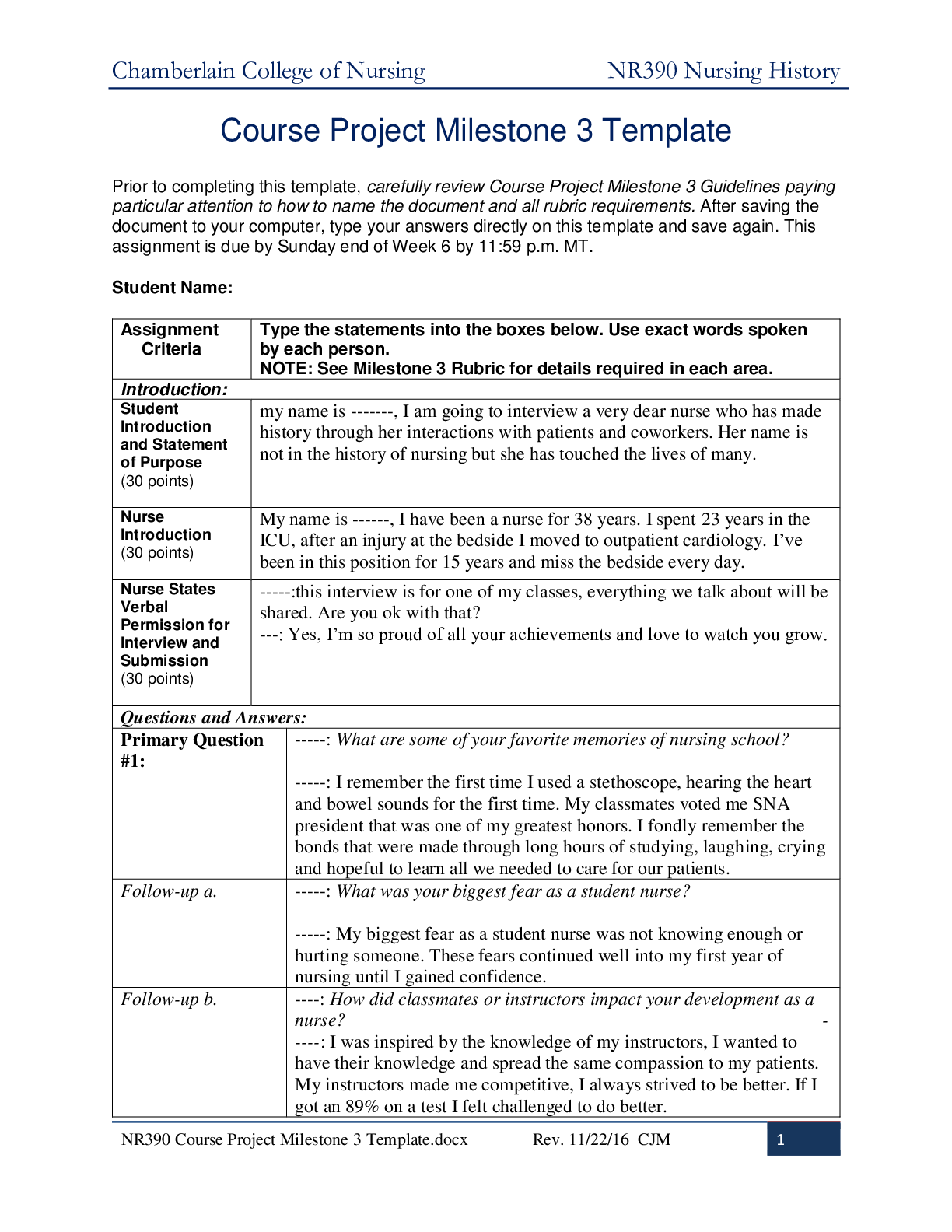Micro Biology > STUDY GUIDE > MICROBIOLO BIOS242 Micro-FINAL STUDYGUIDE | (Guaranteed ACE) | Chamberlain College of Nursing (All)
MICROBIOLO BIOS242 Micro-FINAL STUDYGUIDE | (Guaranteed ACE) | Chamberlain College of Nursing
Document Content and Description Below
Final Exam Study Guide 52 Multiple choice – 3pts each 5 Select all that apply – 4pts each 8 Fill in the blank – 3pts each 3 Short Answer/Essay – 10 pts each 1. Name the viral infection ... characterized by unusual oral lesions called Koplik’s spots followed by red maculopapular exanthema. Measles 2. What microbe causes stomach ulcers (gastric ulcers) Helicobacter pylori 3. What infectious class of organisms is known to be transmitted by pork and stimulates production of eosinophils? Helminthic 4. Which type of hypersensitivity involves only cell mediated immunity? Type IV. 5. Know examples of signs and symptoms Type 1- Anaphylactic, hives, wheal and erythema Type 2- asthma, rhinitis, dermatitis and Type 3-skin disposition vasculitic (skin), serum sickness (systemic), nephritis (kidneys) and extrinsic allergic alveolitis (lungs) Type 4- often called delayed type hypersensitivity as the reaction takes several days to develop. Many chronic infectious diseases, including tuberculosis and fungal infections, exhibit delayed hypersensitivity. 6. Define carrier of disease A person or organism infected with an infectious disease agent but displays no symptoms. Also known as Asymptomatic carrier. 7. Know the classes of immunoglobulins & their function IgG- Main blood antibody of secondary responses, neutralizes toxins, opsonization IgM-Main antibody of primary responses, best at fixing complement; the monomer form of IgM serves as the B cell receptor. IgA-Secreted into mucus, tears, saliva and colostrum IgE- Antibody of allergy and antiparasitic activity. IgD- B cell receptor 8. Which antibiotics work to inhibit synthesis of peptidoglycan in bacterial cell walls? Penicillins and cephalosporins 9. List all of the noncellular infectious agents • Viruses • Virions • Viroids 10. List the types of parasitic helminths • Roundworms • Pinworm • Trichina • Spiralis • Tapeworm • Fluke 11. List the methods of horizontal gene transfer • Transformation • Transduction • Bacterial conjugation 12. Does glycolysis occur in the absence of oxygen? Is pyruvic acid, CO2 & H2O end products of glycolysis? Does glycolysis occur during fermentation? Does glycolysis reduce NAD? Glycolysis occurs when glucose and oxygen are supplied to the cells by the bloodstream, and it takes place in the cell's cytoplasm. Glycolysis can also occur without oxygen, a process called anaerobic respiration, or fermentation. When glycolysis occurs without oxygen, cells make small amounts of ATP Is pyruvic acid, CO2 & H2O end products of glycolysis? Yes Does glycolysis occur during fermentation? . Glycolysis can also occur without oxygen, a process called anaerobic respiration, or fermentation. When glycolysis occurs without oxygen, cells make small amounts of ATP Does glycolysis reduce NAD? In the process of glycolysis, NAD+ is reduced to form NADH + H+. If NAD+ is not present, glycolysis will not be able to continue. During aerobic respiration, the NADH formed in glycolysis will be oxidized to reform NAD+ for use in glycolysis again 13. What type of microbe is Trichomonas vaginalis and what condition does it cause? It is a parasitic protozoan. It causes Trichomoniasis this condition. 14.Describe the signs/symptoms of HSV-2 infections Signs/symptoms • Itching • Fever • Swollen lymph nodes • Headaches • Lack of appetite • Pain during urination • Blistering sores in mouth 15. What was the purpose of the Tuskegee Study? The purpose of the study was to study the natural progression of the disease (experiment in nature). The purpose was to see what happens when men with late syphilis were left untreated if there are differences in the disease by race. 16. Know the morphological characteristics, virulence factors and diseases caused by N. gonorrhoeae • Morphological characteristics – It is a gram negative, non-spore forming, non-motile, encapsulated and non- acid fast bacteria, which appear in kidney beans shape under the microscope. • Virulence factors – It does not produce any exotoxins. The first stages of infection, involving adherence and invasion, are mediated by surface components of the gonococci. • Diseases caused – infection of the genitals, throat, and eyes, infects the mucous membranes of the reproductive tract including the cervix, uterus and fallopian tubes in women and the urethra in women and men. 17. What condition is caused by Candida albicans? Candida albicans is the most common cause of genital yeast infections. 18. Differentiate among the main types of hepatitis and discuss causative agents, modes of transmission, diagnostic techniques, prevention, and treatment of each. Hepatitis B Causative agents- A hepadnaviral that attacks the liver causing inflammation of the liver Mode of transmission-Transmitted by minute amounts of blood Diagnostic techniques Blood tests. Blood tests can detect signs of the hepatitis B virus in your body Liver ultrasound. A special ultrasound called transient elastography can show the amount of liver damage. Liver biopsy. Your doctor might remove a small sample of your liver for testing. Prevention Wash your hands thoroughly with soap and water after any potential exposure to blood. Use condoms with sexual partners. Avoid direct contact with blood and bodily fluids. Clean up blood spills with a fresh diluted bleach solution. Cover all cuts carefully. Avoid illegal street drugs. Make sure new, sterile needles are used for ear or body piercing, tattoos, and acupuncture. Treatment An effective vaccine is available Hepatitis A Causative agents- A hepatovirus from the Picornaviridae family. Mode of Transmission-Fecal–oral route, associated with deficient personal hygiene and lack of public health measures. Diagnostic techniques Blood Test Prevention Wash your hands thoroughly after using the restroom and when you come in contact with an infected person's blood, stools, or other bodily fluid. Avoid unclean food and water. Treatment Immunizations are available Hepatitis C Mode of Transmission Transmitted by minute amounts of blood, Blood transfusions, needle sharing Diagnostic techniques- Blood Test Prevention- Wash your hands thoroughly with soap and water after any potential exposure to blood. Use condoms with sexual partners. Avoid direct contact with blood and bodily fluids. Clean up blood spills with a fresh diluted bleach solution. Cover all cuts carefully. Avoid illegal street drugs. Make sure new, sterile needles are used for ear or body piercing, tattoos, and acupuncture. Treatment-No vaccine available. Two-drug regimen: Sofosbuvir (a nucleotide analog that "fools" the RNA polymerase of the virus) and simeprevir (a protease inhibitor) 19. Name eight bacterial and three nonbacterial causes of acute diarrhea and identify the most common cause of food-borne illness in the United States. Eight bacterial 1) E. Coli 2) Salmonella 3) Shigella 4) Campylobacter 5) Vibrio cholerae 6) Clostridium difficile Three nonbacterial causes of acute diarrhea 1) Rotavirus 2) Cryptosporidium 3) Norovirus Identify the most common cause of food-borne illness in the United States. Norovirus 20. What disease characteristic is specific for Vibrio cholerae? It is a gram negative, comma-shaped & non-spore forming. It is very motile and has a single polar flagellum. 21. Compare and contrast antigenic drift and antigenic shift in influenza viruses. Influenza Type A viruses undergo both kinds of antigenic drift and shift. Influenza type B viruses change only by the more gradual process of antigenic drift Antigenic drift: Gradual changing of amino acid composition of influenza antigens Results in decreased ability of host memory cells to recognize them are Small changes in the genes of influenza viruses that happen continually over time as the virus replicates Changes all the time, Antigenic shift: Swapping out of one of the strands of viral RNA with a gene or strand from another virus No recognition by host memory cells Often results in influenza pandemics An abrupt, major change in the influenza A viruses Change happens only occasionally 22. Know characteristics of Histoplasma capsulatum Darling’s disease, Ohio Valley fever, spelunker’s disease Dimorphic fungus Can be benign or severe, acute or chronic Most serious forms occur in patients with AIDS Chronic pulmonary histoplasmosis: signs and symptoms like tuberculosis Endemic to all continents except Australia High prevalence in OH, IL, MO, KY, TN, MI, GA, and AR 23.How do you diagnose tuberculosis? Mantoux test shows evidence of delayed hypersensitivity after initial infection with TB Purified protein derivative is injected under the skin and observed for evidence of an induration indicating delayed hypersensitivity IGRA: blood test to determine T-cell reactivity to M. tuberculosis Acid-fast staining of sputum sample PCR methods Chest X-rays verify TB when other tests give indeterminate results 24.Know possible causative agents, modes of transmission, virulence factors, diagnostic techniques, and prevention and treatment for streptococcal pharyngitis Causative agent- Group A Streptococcus Virulence Factors- LTA, M protein, hyaluronic acid capsule, SLS and SLO, superantigens, induction of autoimmunity Diagnostic techniques- Beta-hemolytic on blood agar, Sensitive to bacitracin Rapid antigen test Mode of Transmission- Droplet or direct contact Prevention- Hygiene Practices Treatment- penicillin 25. How does infection travel to the middle ear to cause otitis media? Bacteria or viruses travel up the eustachian tube into the middle ear and multiply to cause an ear infection 26. Know the symptoms of infectious mononucleosis Fatigue, sore throat, swollen lymph nodes, fever, headache, nausea 27. What is the major method of preventing brucellosis? Do not consume undercooked meat or unpasteurized dairy products. People who are in contact with animal tissue such as hunters need to wear gloves, goggles, and aprons to keep bacteria from getting into eyes or a cut. 28. What is sepsis? Sepsis is the body’s extreme response to an infection. It happens when an infection you already have in your skin, lungs, urinary tract, or somewhere else triggers a chain reaction throughout your body. Without quick treatment, sepsis can rapidly lead to tissue damage, organ failure, and death. 29. List the causative agent, reservoir, mode of transmission, symptoms and treatment for Rabies Causative Agent: Rabies is caused by Rhabdoviruse. A negative-stranded RNA virus of the family Rhabdoviridea. Reservoir: Rabies is a zoo-nose, meaning that it is a disease that is transmitted to humans via domestic or wild animals. Bats, raccoons, skunks, and foxes are the major reservoir and primary cause of infection to other animals and humans. Mode of Transmission: Rabies is usually transmitted through a bite from an infected animal. Transmission between humans is extremely rare, although it can happen through organ transplants, or through bites. Symptoms: Irritability, agitation, confusion, muscle spasms, nausea, vomiting, fever Treatment: The rabies vaccine can prevent it, rabies shots asap after being bit, if nothing is done and symptoms appear, its almost always fatal. 30. What is Subacute sclerosing panencephalitis? A progressive neurological disorder in children and young adults that affects the central nervous system. It is a slow, but persistent, viral infection caused by defective measles virus. 31. List all of the diseases caused by prions Creutzfeldt-Jakob Disease (CJD), Variant Creutzfeldt-Jakob Disease (vCJD), Bovine Spongiform Encephalopathy (BSE) or "Mad Cow Disease”, Kuru, Scrapie 32. Know all of the disease/infections caused by Staphylococcus aureus and their signs/symptoms Skin infections (swollen, painful, drainage) impetigo (crusty) food poisoning (nausea and vomiting) cellulitis (red, hot and swollen) toxic shock syndrome (high fever, low blood pressure, vomiting, diarrhea) bone infections (pain, swelling, fever and chills) endocarditis (flu like symptoms, rapid heartbeat, fluid buildup) pneumonia (high fever, chills, cough) 33. List the autoimmune diseases that are due to tissue damage from autoantigens multiple sclerosis, myasthenia gravis, psoriasis, rheumatoid arthritis, and systemic lupus erythematosus. 34. List the symptoms of Type 1 hypersensitivities allergic rhinitis (hay fever), conjunctivitis, hives, angioedema 35. What is the function of each type of T cell? CD4+ Helper Cells- help in the maturation of B cells into plasma cells and memory B cells. They also help activate cytotoxic T cells and macrophages. CD8+ Cytotoxic Cells- CD8+ cytotoxic cells cause lysis of virus-infected and tumour cells. They are also involved in transplant rejection. Memory T Cells- They provide the immune system with “memory” against previously encountered pathogens. Natural Killer T Cells- They bridge the adaptive immune system with the innate immune system. 36. Define antigen a toxin or other foreign substance which induces an immune response in the body, especially the production of antibodies. 37. What are the components of your second line of defense? Antimicrobial substances, phagocytes, natural killer cells, inflammation and fever. 38. What is the function of basophils? Prevents blood from clotting too quickly and promotes blood flow to tissue. 39. What are monocytes and what is their job in immune response? Monocytes are a large phagocytic white blood cell with a simple oval nucleus and clear, grayish cytoplasm. Their job is to attack germs that enter the body and fight off bacteria, fungi and viruses. 40. List the nonspecific chemical defenses Nonspecific defenses include physical and chemical barriers, the inflammatory response, and interferons. 41. What are hemolysins, coagulase, slime layer, fimbriae, capsules Hemolysins: exotoxins that are able to destroy red blood cells and hemoglobin Coagulase: the coagulase test is the ability of an organism to coagulate plasma (the fluid portion of blood Slime layer: loosely attached, polypeptide Fimbriae: fimbriae are found in Gram-negative as well as in gram-positive bacteria at cell surface Capsules: strongly attached, polysaccharide 42.Define TORCH toxoplasmosis, rubella cytomegalovirus, herpes simplex, and HIV 43.List the important characteristics of antimicrobial drugs readily delivered to the site of infection. high toxicity against microbial cells. do not cause serious side effects in humans. remains active in body tissues and fluids. 44. Define disinfection, sterilization, degermation, antisepsis, sanitization Disinfection: Process or agent that destroys microorganisms but may NOT kill bacterial spores Sterilization: Process by which all forms of life, including bacterial spores are destroyed by physical or chemical means Degermation: reduces the number of microbes on the human skin (mechanical) Antisepsis: destroys most microbial life, reducing contamination on a living surface (not endospores) Sanitation: Process by which the # of microorganisms is reduced to relatively safe levels (reduction of microbial load) 45. Why are antiviral drugs difficult to create? Viruses utilize the host cell processes, so killing them is often toxic to the patient 46.Viruses that cause infection resulting in alternating periods of activity with symptoms and inactivity without symptoms are called _Latent . 47. What are dimorphic fungi? have the ability to grow both as yeasts and molds, depending on the conditions acquired by inhalation of airborne spores from soil; cause systemic mycoses 48. Which 2 organisms are included in the kingdom Protist? The protists are a diverse group of eukaryotes that cannot be classified as animals, plants, or fungi. Organisms in the Protista kingdom include amoebae, red algae, dinoflagellates, diatoms, euglena, and slime molds 49. Know the features of fermentation • Fermentation is the incomplete oxidation of glucose or other carbohydrates in the absence of oxygen. • Organic molecules processed through Respiration or Fermentation release energy in the form of ATP. • Facultative anaerobes and aerotolent anaerobes adopt anaerobic metabolism (fermentation) when O2 is absent. • Fermentation is the third basic catabolic pathway, along aerobic and anaerobic respiration • Fermentation only uses glycolysis • Organic compounds is used as an electron acceptor in fermentation pathway • Fermentation yields a small amount of ATP and occurs in glycolysis • Fermentation forms acid gas and other products by action of various bacteria on pyruvic acid • Fermentation products group in two categories of alcoholic fermentation and acidic fermentation ◦ Alcoholic fermentation occurs in yeast or bacteria, species that metabolic pathways for converting pyruvic acid to ethanol ◦ Acidic fermentation extremely varies • Mixed acid fermentation produces combo of acetic, latic, succinctly and Formica acid Lowers the PH of a medium to 4.0 • Fermentation of a glucose molecule has potential to produce a net output of 2 ATPs 50. Smallpox was globally eradicated in 1977 according to the WHO. Have other diseases been eradicated? Why can some diseases never be eradicated? Small pox and rinderpest (kills cattle) have been eradicated by vaccines • Some diseases can never be eradicated because they my meet all criteria of eraducable diseases: ◦Must be easy to diagnose, can’t lie dormant in patient for so long ◦ Must rise and decline, must induce immunity in survivors ◦ Can’t have animal reservoir ◦ Vaccine or treatment must be easy to administer ◦ Must be severe and widespread 51. Which metabolic pathway creates the most NADH? • Krebs cycle creates the most NADH 52. Know the difference between an aerobe, obligate anaerobe, microaerophile, facultative anaerobe and obligate aerobe • Aerobe (aerobic organism): ◦ Can use gaseous oxygen in its metabolism ◦ Possesses the enzymes needed to process toxic oxygen products • Obligate aerobe: an organism that cannot grow without oxygen • Microaerophile: ◦ Does not grow at normal atmospheric concentrations of oxygen ◦ Requires a small amount of oxygen in its metabolism ◦ Usually live in a habitat that provides a small amount of oxygen but is not directly exposed to the atmosphere • Facultative anaerobe: ◦ An aerobe that does not require oxygen for its metabolism ◦ Capable of growth in the absence of oxygen ◦ Metabolizes by aerobic respiration when oxygen is present ◦ Adopts anaerobic metabolism (fermentation) when oxygen is absent • Strict or obligate anaerobes: ◦ cannot tolerate free oxygen and will die in its presence ◦ Live in highly reduced habitats such as lakes, oceans, and soil 53.How does refrigeration work to control microbial growth? • Some microbes are killed by cold temperatures • In lab, refrigeration is used to slow progression of the death phase so that cultures will remain viable as long as possible. • Preventing unwanted growth in foods in long term storage is best achieved by refrigeration or freezing 54. List examples of differential staining • Differential Stains: use two differently colored stains to clearly contrast cell types or cell parts ◦Gram stain: it remains the universal diagnostic staining technique for bacteria ‣ Permits ready differentiation of major categories based on the color reaction of cells: ◦ Gram-positive bacteria stain purple ◦ Gram-negative bacteria stain pink ◦ Acid-fast stain: Differentiates. acid-fast bacteria from. nonacid-fast bacteria ‣ Acid-fast bacteria stain pink ‣ Nonacid-fast bacteria stain blue ‣ Detects the agents of tuberculosis and leprosy ◦ Endospore stain: Used to distinguish endospores from vegetative cells ‣ Detects endospore-forming members of the genera. Bacillus and Clostridium. ◦ Flagella Stain: Flagella. must be enlarged in order to be seen. A coating is deposited on the outside of the filament and then stained. ◦ Capsule stain: An unstructured protective layer. surrounding the cells of some bacteria and fungi ‣ Visualized through negative staining with India ink or special positive stains ‣ Useful in identifying. pathogens such as Cryptococcus 55. What does it mean when a microbe is described as fastidious? An organism which as a complex or particular nutritional requirements. It will not grow without specific factors present or in specific conditions 56. What is gene therapy? • Gene therapy repair or correction of a faulty gene in humans suffering from a fatal or debilitating disease • Benefit of gene therapy causes Permanent cure of the physical dysfunction by repairing the genetic defect. 57. Which is more likely to result in disease – capsulated or unencapsulated bacteria? Capsulated bacteria are more likely to cause disease. The capsule protects a bacterium from the phagocytic host defenses. Unencapsulated bacteria are not pathogenic. Page 249 58. Describe evolution in terms of the last universal common ancestor Cellular organisms that preceded our current cell types arose on this planet about 3.5 billion years ago, according to the fossil record. It appears that they were the only living inhabitants until about 2.9 billion years ago. At that time, a cell called the last universal common ancestor, or LUCA, seems to have given rise to three types of cells. Two of these were bacteria and archaea, and the third was a more complex type of single-celled organism, the eukaryote (yoo″-kar-ee-ote). Eukary means true nucleus, because these were the only cells containing a nucleus. Bacteria and archaea have no true nucleus. For that reason, they have traditionally been called prokaryotes (meaning prenucleus). But researchers are suggesting we no longer use the term prokaryote because archaea and bacteria are so distant genetically. 59. What is ATP Adenosine Triphosphate is the energy of molecule cells. ATP is a nucleotide containing adenine, ribose, and three phosphates rather than just one. It belongs to a category of high-energy compounds (also including guanosine triphosphate [GTP]) that give off energy when the bond is broken between the second and third (outermost) phosphates. The presence of these high-energy bonds makes it possible for ATP to release and store energy for cellular chemical reactions. Breakage of the bond of the terminal phosphate releases energy to do cellular work and also generates adenosine diphosphate (ADP). ADP can be converted back to ATP when the third phosphate is restored, thereby serving as an energy depot. Carriers for oxidation-reduction activities (nicotinamide adenine dinucleotide [NAD], for instance) are also derivatives of nucleotides. Page 48 60. Know the work tasks of industrial, public health, medical, agricultural and environmental microbiologists Work task of microbiologist: Industrial: This branch safeguards our food and water, and also includes biotechnology, the use of microbial metabolism to arrive at a desired product, ranging from bread making to gene therapy. Microbes can be used to create large quantities of substances such as amino acids, beer, drugs, enzymes, and vitamins. Public health: These branches monitor and control the spread of diseases in communities. Institutions involved in this work are the U.S. Public Health Service (USPHS) with its main agency, the Centers for Disease Control and Prevention (CDC) located in Atlanta, Georgia, and the World Health Organization (WHO), the medical limb of the United Nations. Medical: This branch deals with microbes that cause diseases in humans and animals. Researchers examine factors that make the microbes virulent and mechanisms for inhibiting them. Agricultural: This branch is concerned with the relationships between microbes and domesticated plants and animals. Plant specialists focus on plant diseases, soil fertility, and nutritional interactions. Animal specialists work with infectious diseases and other associations animals have with microorganisms. Environmental: These microbiologists study the effect of microbes on the earth’s diverse habitats. Whether the microbes are in freshwater or saltwater, topsoil or the earth’s crust, they have profound effects on our planet. Subdisciplines of environmental microbiology are Aquatic microbiology—the study of microbes in the earth’s surface water; Soil microbiology—the study of microbes in terrestrial parts of the planet; Geomicrobiology—the study of microbes in the earth’s crust; and Astrobiology (also known as exobiology)—the search for/study of microbial and other life in places off of our planet. 61. Which of the following scientist disapproved the theory of spontaneous generation? One of the first scientists to test the theory of spontaneous generation was Francesco Redi using a simple experiment. 62. Explain the role of CD4 (T helper cells) in the progression from patients from being HIV positive to having AIDS. Why over the years the incidence of HIV infection has declined in the United States while the prevalence of AIDS has increased. human immunodeficiency virus (HIV) attaches to the CD4 protein on certain white blood cells. The mode of attachment varies between the two general types of viruses. In enveloped forms such as influenza virus and HIV, glycoprotein spikes bind to the cell membrane receptors (figure 6.12). 63. Describe the four different types of acquired immunity. Natural Artificial Active Recovery from an infection Vaccinations Passive Breast feeding Immunotherapy 64. Describe three types of reservoirs of infectious disease in humans. Give an example disease for each type of reservoir. Table 13.7 page 363 Living Nonliving Animal s mammals (rabies), birds (psittacosis), or lizards (salmonellosis) Soil Anthrax Humans tubercle bacillus and the influenza virus Air Coccidioide Arthrop ods (Mosqu itos) Malaria Water Dysentery Shigella dysenteriae bacteria or Entamoeba histolytica amoeba gastro- intestinal Cryptosporidiosis Cryptosporidium parvum protozoa gastro-intestinal Giardia Food L. monocytogenes 65. What is Diphtheria? How do you treat it? What is the morphological and gram stain characteristics of the causative agent? What are its virulence factors? Diphtheria is an infection caused by the bacterium Corynebacterium diphtheriae. Diphtheria causes a thick covering in the back of the throat. It can lead to difficulty breathing, heart failure, paralysis, and even death. CDC recommends vaccines for infants, children, teens and adults to prevent diphtheria. How do you treat it? 1. An antitoxin. If doctors suspect diphtheria, the infected child or adult receives an antitoxin. The antitoxin, injected into a vein or muscle, neutralizes the diphtheria toxin already circulating in the body. ... 2. Antibiotics. Diphtheria is also treated with antibiotics, such as penicillin or erythromycin. What is the morphological and gram stain characteristics of the causative agent? Corynebacterium diphtheria is a nonmotile, noncapsulated, club-shaped, Gram- positive bacillus. Toxigenic strains are lysogenic for one of a family of corynebacteriophages that carry the structural gene for diphtheria toxin, tox What are its virulence factors? The main virulence factor of C. diphtheriae is diphtheria toxin (DT), an exotoxin, released by the bacteria after entering the human body. DT is classified as an AB toxin because it has two components, one for activation and one for binding. 66.Explain whether there is a greater risk for E. coli O157:H7 infection when consuming a hamburger compared to consuming a steak (5points). Discuss whether or not food poisoning can still occur after consuming a reheated pot of soup known to be contaminated with Staphylococcus aureus Whole cuts of meat such as steaks or roasts usually only have E. coli on the surface, which makes the E. coli easier to kill by cooking. This is why ground meat and mechanically tenderized meat are more likely to cause illness than whole cuts of meat. E. coli can be killed if the meat is cooked thoroughly. Discuss whether or not food poisoning can still occur after consuming a reheated pot of soup known to be contaminated with Staphylococcus aureus People can contract the illness by eating food that is contaminated with Staph aureus, usually because the food has not been kept hot enough or cold enough. Staph bacteria grow and reproduce at temperatures from 50 degrees F to 120 degrees F, with the most rapid growth occurring near body temperature (about 98 degrees F). The toxin produced by staph bacteria is very heat-stable—it is not easily destroyed by heat at normal cooking temperatures. The bacteria themselves may be killed, but the toxin remains. Re-heating foods, even at high temperatures, that have been contaminated with toxins will NOT make them safe to eat! [Show More]
Last updated: 1 year ago
Preview 1 out of 19 pages
Instant download
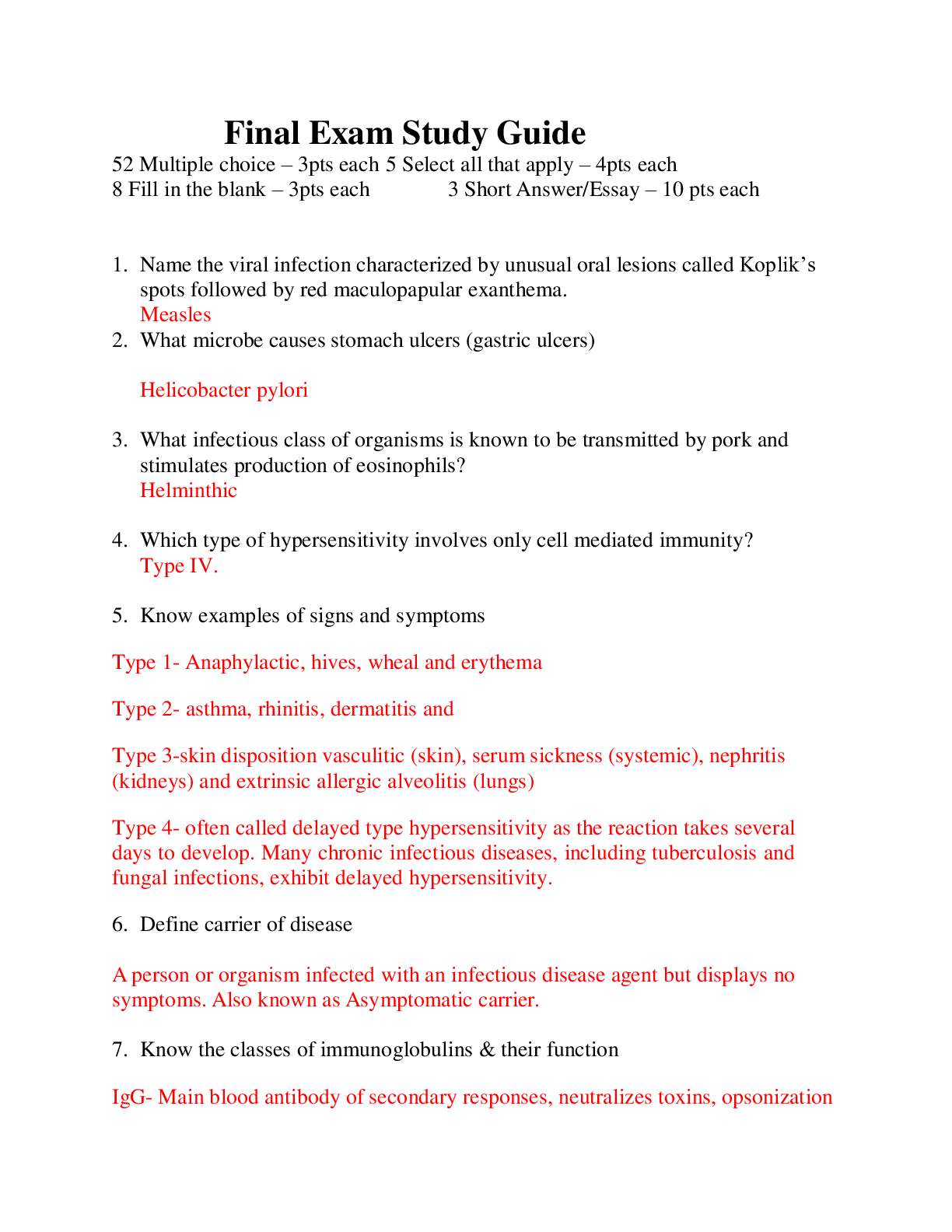
Buy this document to get the full access instantly
Instant Download Access after purchase
Add to cartInstant download
Reviews( 0 )
Document information
Connected school, study & course
About the document
Uploaded On
Jul 28, 2021
Number of pages
19
Written in
Additional information
This document has been written for:
Uploaded
Jul 28, 2021
Downloads
0
Views
84











